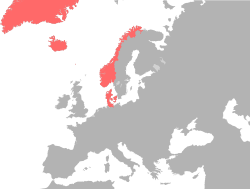Denmark-Norway
Denmark-Norway is a term (or a kind of name used about) the union between Denmark and Norway. The union was a kind that is called a real union. The name Denmark-Norway, is a modern name. It came into use some time after the union had ended.
Denmark–Norway Danmark–Norge | |||||||||||
|---|---|---|---|---|---|---|---|---|---|---|---|
| 1523–1533 1537–1814 | |||||||||||
 Map of Denmark–Norway, c. 1780 | |||||||||||
| Status | Personal union (1524–1533) Dual monarchy (Real union) (1537–1814)[1] | ||||||||||
| Capital | Copenhagen and Oslo (Only in Norway 1523–1537) | ||||||||||
| Common languages | Official: Danish, German, Renaissance Latin Also spoken: Norwegian, Icelandic, Faroese, Sami, Greenlandic | ||||||||||
| Religion | Lutheran | ||||||||||
| Government | Elective monarchy 1523–1660 (Denmark) Hereditary monarchy 1660–1814 (Denmark) (Absolutism since 1660) Elective monarchy 1523–1537 (Norway (de facto)) Hereditary monarchy 1537–1814 (Absolutism since 1661) | ||||||||||
| King | |||||||||||
• 1524–1533 | Frederick I | ||||||||||
• 1588–1648 | Christian IV | ||||||||||
• 1648–1670 | Frederick III | ||||||||||
• 1808–1814a | Frederick VI | ||||||||||
| Legislature |
| ||||||||||
| Historical era | Early modern Europe | ||||||||||
June 6, 1523 | |||||||||||
• Kalmar Union collapsed | 1523 | ||||||||||
1537 | |||||||||||
October 14, 1660 | |||||||||||
November 14, 1665 | |||||||||||
• Treaty of Brömsebro | August 13, 1645 | ||||||||||
• Treaty of Roskilde | February 26, 1658 | ||||||||||
• Treaty of Kiel | January 14, 1814 | ||||||||||
• Congress of Vienna | September 1814 – June 1815 | ||||||||||
| Area | |||||||||||
| 1780b | 487,476 km2 (188,216 sq mi) | ||||||||||
| Population | |||||||||||
• 1645c | 1315000 | ||||||||||
• 1801d | 1859000 | ||||||||||
| Currency | |||||||||||
| |||||||||||
| Today part of | |||||||||||
| |||||||||||
The Kingdom of Denmark-Norway was a union between the two kingdoms Denmark and Norway. They were previously in the Kalmar Union with Sweden. The Kingdom of Denmark-Norway lasted from 1536 to 1814.[5][6] The capital of both countries was Copenhagen, and they shared the same military. The kingdom also possessed colonies in Greenland, Iceland, Africa, the Caribbean and India.
Borders between nations, sometimes change. Denmark-Norway had (some) land in what today is
Denmark-Norway had a small colony in each of the following places
- Present-day Saint Thomas and Saint Croix,
 United States and present-day Saint John.
United States and present-day Saint John.  India
India Ghana
Ghana
Monarchs
change- 1524–1533: Frederick I
- 1588–1648: Christian IV
- 1648–1670: Frederick III
- 1808–1814: Frederick VI
References
change- ↑ citation |last=Slagstad |first=Rune |title=Shifting Knowledge Regimes: the Metamorphoses of Norwegian Reformism |year=2004 |journal=Thesis Eleven |volume=77 |issue=1 |pages=65–83 |doi=10.1177/0725513604044236 |s2cid=145108242}}
- ↑ regjeringen.no (5 July 2011). "A Forerunner to the Norwegian Council of State". Government.no.
- ↑ Historisk Tidsskrift: Nyt om Trediveårskrigen (in Danish)
- ↑ Tacitus.no – Skandinaviens befolkning (in Swedish)
- ↑ "Denmark". World Statesmen. Retrieved 18 January 2015.
- ↑ "Norway". World Statesmen. Retrieved 18 January 2015.

